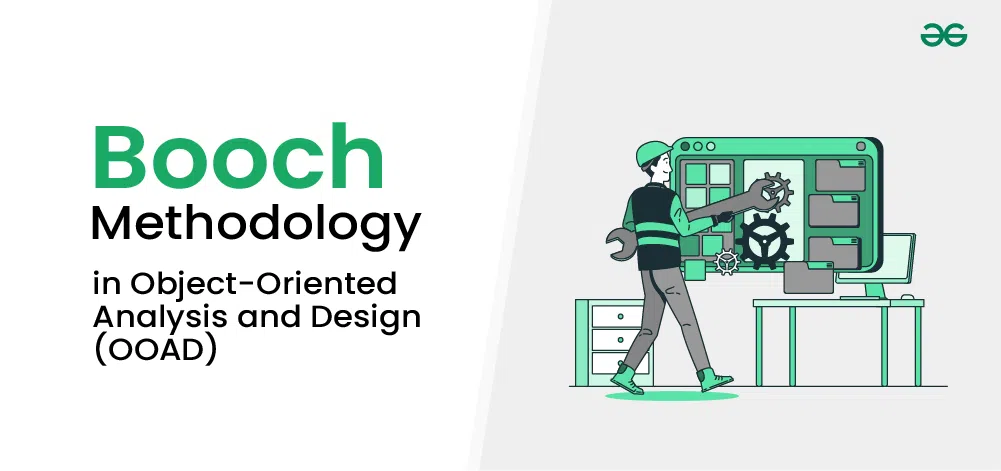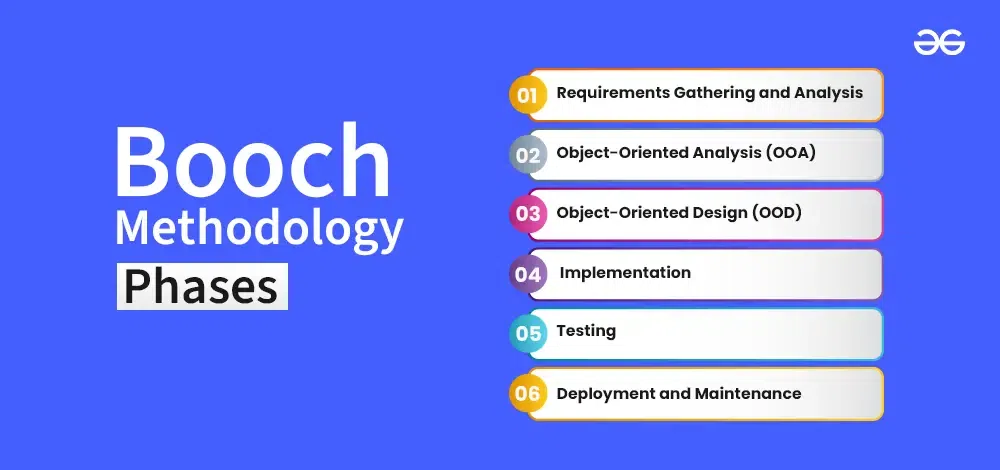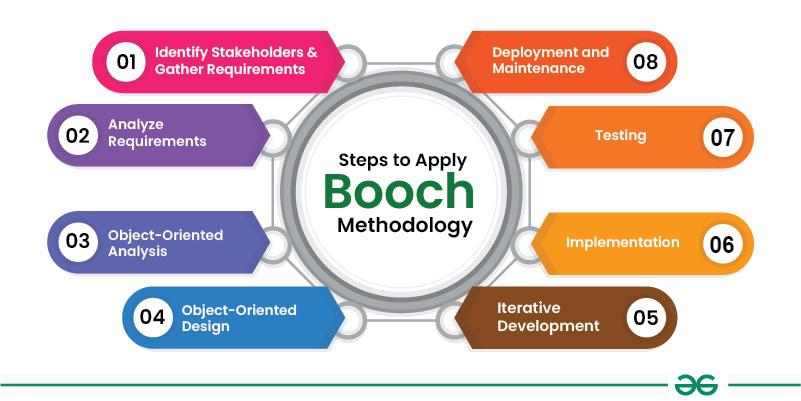The Booch Methodology is a foundational framework in Object-Oriented Analysis and Design (OOAD). Engineered by Grady Booch, this methodology encapsulates principles, strategies, and techniques essential for crafting resilient and adaptable software systems. In this article, we will see the features of the Booch Methodology and its significance in the field of OOAD.

Important Topics for the Booch Methodology in OOAD
What is Booch Methodology?
The Booch Methodology is an approach to software development, particularly in Object-Oriented Analysis and Design (OOAD), pioneered by Grady Booch. It provides a systematic framework for designing and developing software systems using object-oriented principles. The methodology encompasses various stages of the software development lifecycle, including requirements analysis, system design, implementation, and testing.
Key components of the Booch Methodology include object modeling, class diagrams, dynamic modeling, and architectural design. It emphasizes modularity, encapsulation, and abstraction to create flexible and maintainable software solutions.
Key Elements of Booch Methodology
The Booch Methodology comprises several key elements that guide the process of object-oriented analysis and design (OOAD) and software development. These elements include:
- Object Modeling: Identifying and modeling the key entities and objects within the system, along with their attributes, behaviors, and relationships. Object modeling serves as the foundation for the entire development process.
- Class Diagrams: Creating class diagrams to visually represent the static structure of the system, including classes, their attributes, methods, and associations. Class diagrams provide a blueprint for designing the software architecture.
- Dynamic Modeling: Analyzing and modeling the dynamic behavior of the system, including interactions between objects, state transitions, and sequence diagrams. Dynamic modeling helps understand how the system behaves over time and in response to various inputs.
- Architectural Design: Designing the overall architecture of the system, including the organization of classes, modules, and components, as well as defining interfaces and dependencies. Architectural design ensures that the system is scalable, maintainable, and adaptable to changes.
- Object-Oriented Design Principles: Applying fundamental object-oriented design principles such as encapsulation, inheritance, polymorphism, and abstraction to ensure modular and reusable code.
- Iterative and Incremental Development: Embracing an iterative and incremental approach to software development, where the system evolves through multiple cycles of analysis, design, implementation, and testing. This allows for feedback-driven refinement and continuous improvement.
- Documentation: Creating comprehensive documentation to capture the requirements, design decisions, and implementation details of the system. Documentation serves as a reference for developers, testers, and other stakeholders throughout the project lifecycle.
- Tool Support: Leveraging appropriate tools and technologies to facilitate the modeling, design, implementation, and testing activities. Tools such as UML modeling tools, integrated development environments (IDEs), and version control systems enhance productivity and collaboration.
Booch Methodology Phases
The Booch Methodology encompasses several phases that guide the process of object-oriented analysis and design (OOAD) and software development. These phases include:

1. Requirements Gathering and Analysis
In this initial phase, the focus is on understanding the stakeholders’ requirements and analyzing the problem domain. Requirements are gathered through interactions with stakeholders, including end-users, clients, and domain experts. The goal is to identify the functional and non-functional requirements that the software system must fulfill.
2. Object-Oriented Analysis (OOA)
During the OOA phase, the emphasis is on modeling the problem domain using object-oriented concepts. Object modeling techniques, such as use case diagrams, class diagrams, and interaction diagrams, are employed to capture the structure, behavior, and relationships of the system’s entities and objects. The goal is to develop a clear understanding of the problem domain and define the system’s requirements in terms of objects and their interactions.
3. Object-Oriented Design (OOD)
In the OOD phase, the focus shifts to designing the solution architecture based on the requirements identified during the analysis phase. Design decisions are made regarding the organization of classes, modules, and components, as well as the definition of interfaces and relationships between objects. Object-oriented design principles, such as encapsulation, inheritance, and polymorphism, are applied to ensure modularity, reusability, and maintainability of the software.
4. Implementation
During the implementation phase, the design specifications are translated into executable code. Object-oriented programming languages, such as Java or C++, are typically used to implement the classes and components defined in the design phase. The emphasis is on writing clean, modular, and well-documented code that adheres to the design specifications and coding standards.
5. Testing
The testing phase involves verifying and validating the software system to ensure that it meets the specified requirements and functions correctly. Various testing techniques, including unit testing, integration testing, and system testing, are employed to identify and fix defects or bugs in the software. The goal is to ensure the reliability, robustness, and quality of the software before deployment.
6. Deployment and Maintenance
Once the software has been thoroughly tested and validated, it is deployed into the production environment for end-users to use. The deployment phase involves activities such as installation, configuration, and user training. After deployment, the software enters the maintenance phase, where updates, enhancements, and bug fixes are made to address evolving user needs and ensure the long-term viability of the system.
By following these phases in the Booch Methodology, software development teams can systematically analyze, design, implement, test, deploy, and maintain high-quality object-oriented software systems that meet the needs of stakeholders and end-users.
Important Techniques/Diagrams for Booch Methodology
In the Booch Methodology and object-oriented analysis and design (OOAD) in general, several popular techniques and diagrams are commonly used to model and design software systems:
- Use Case Diagrams: Use case diagrams depict the interactions between users (actors) and the system, illustrating various use cases or functionalities offered by the system. They help in understanding the system’s requirements from a user’s perspective and identifying primary actors and their interactions with the system.
- Class Diagrams: Class diagrams represent the static structure of the system by showing classes, their attributes, methods, and relationships. They provide a visual representation of the system’s object-oriented design, including inheritance, association, aggregation, and composition relationships between classes.
- Sequence Diagrams: Sequence diagrams illustrate the dynamic behavior of the system by showing the sequence of interactions between objects over time. They depict how objects collaborate to accomplish a specific task or use case, including the exchange of messages and the order of method invocations.
- Collaboration Diagrams: Collaboration diagrams, also known as communication diagrams, visualize the interactions between objects by showing the links between objects and the messages exchanged between them. They provide a more detailed view of object interactions compared to sequence diagrams, focusing on the structure of the interactions rather than the sequence.
- State Diagrams: State diagrams, or state machine diagrams, model the behavior of individual objects or system components by depicting their states and the transitions between states triggered by events. They are particularly useful for modeling the lifecycle of objects and capturing complex behaviors with distinct states and transitions.
- Activity Diagrams: Activity diagrams represent the flow of control or workflow within the system, showing the sequence of activities or actions performed by objects or system components. They are often used to model business processes, use case scenarios, or system behaviors that involve multiple actors and steps.
- Package Diagrams: Package diagrams organize classes and other elements into packages or modules, showing the dependencies between packages and the structure of the system’s architecture. They help in managing the complexity of large systems by providing a hierarchical view of the system’s components and their relationships.
- Deployment Diagrams: Deployment diagrams illustrate the physical deployment of software components onto hardware nodes, showing the allocation of software artifacts to hardware resources such as servers, computers, or devices. They help in understanding the system’s deployment architecture and identifying potential scalability and performance issues.
Step-by-step Process to Apply Booch Methodology
Applying the Booch Methodology involves several steps that guide the process of object-oriented analysis and design (OOAD) and software development. Below is a step-by-step process to apply the Booch Methodology effectively:

Step 1: Identify Stakeholders and Gather Requirements
Begin by identifying the stakeholders involved in the project, including end-users, clients, and domain experts. Gather requirements through interviews, workshops, and documentation analysis to understand the needs and objectives of the system.
Step 2: Analyze Requirements
Analyze the gathered requirements to identify the key functionalities and constraints of the system. Use techniques such as use case analysis, scenario analysis, and requirements prioritization to clarify and refine the requirements.
Step 3: Object-Oriented Analysis (OOA)
Model the problem domain using object-oriented analysis techniques. Identify the main objects, classes, attributes, methods, and relationships involved in the system. Use tools such as class diagrams, use case diagrams, and interaction diagrams to represent the analysis model.
Step 4: Object-Oriented Design (OOD)
Design the solution architecture based on the analysis model developed in the previous step. Define the structure of classes, modules, and components, as well as their relationships and interfaces. Apply object-oriented design principles such as encapsulation, inheritance, and polymorphism to ensure modularity and reusability.
Step 5: Iterative Development
Embrace an iterative and incremental approach to software development. Break down the project into smaller iterations or sprints, each focusing on implementing and delivering specific features or functionalities. Continuously gather feedback from stakeholders and refine the design and implementation based on the feedback received.
Step 6: Implementation
Write clean, modular, and well-documented code based on the design specifications developed in the previous steps. Implement the classes, modules, and components defined in the design phase using object-oriented programming languages and frameworks.
Step 7: Testing
Test the software system to ensure that it meets the specified requirements and functions correctly. Perform various testing activities, including unit testing, integration testing, system testing, and acceptance testing, to identify and fix defects or bugs in the software.
Step 8: Deployment and Maintenance
Deploy the tested and validated software into the production environment for end-users to use. Provide installation, configuration, and user training as necessary. Maintain the software by addressing bugs, adding new features, and making enhancements based on user feedback and changing requirements.
Benefits of Booch Methodology
The Booch Methodology offers several benefits in object-oriented analysis and design (OOAD) and software development:
- Structured Approach: Booch Methodology provides a structured and systematic approach to OOAD, guiding developers through the process of analyzing requirements, designing solutions, and implementing software systems.
- Clarity and Understanding: By using visual modeling techniques such as class diagrams, sequence diagrams, and collaboration diagrams, Booch Methodology helps in achieving a clearer understanding of the problem domain and system architecture.
- Modularity and Reusability: Booch Methodology encourages the creation of modular and reusable components, classes, and modules, promoting code reusability and reducing duplication of effort in software development.
- Flexibility and Adaptability: The iterative and incremental nature of Booch Methodology allows for flexibility and adaptability to changing requirements and evolving project needs. Developers can incrementally refine and enhance the software system based on feedback and changing priorities.
- Object-Oriented Principles: Booch Methodology emphasizes object-oriented principles such as encapsulation, inheritance, and polymorphism, which lead to cleaner, more maintainable, and more extensible software designs.
- Collaboration and Communication: Booch Methodology facilitates collaboration and communication among development teams, stakeholders, and end-users through visual models, documentation, and iterative feedback loops.
- Quality and Reliability: By following a disciplined approach to analysis, design, and implementation, Booch Methodology helps ensure the quality and reliability of the software system, reducing the likelihood of defects and bugs.
Challenges of Booch Methodology
While the Booch Methodology offers numerous benefits, it also presents several challenges that developers may encounter during its application:
- Learning Curve: Mastering the Booch Methodology and its associated techniques, such as UML modeling and object-oriented design principles, can require a significant investment of time and effort. Newcomers to the methodology may find it challenging to understand and apply its concepts effectively.
- Complexity: The Booch Methodology involves the creation of detailed models and diagrams to represent the system’s architecture and behavior. Managing the complexity of these models, especially in large-scale projects, can be challenging and may lead to overly complex designs that are difficult to understand and maintain.
- Subjectivity: Decisions made during the analysis and design phases of the Booch Methodology can be subjective and open to interpretation. Different developers may have varying perspectives on how to model the system or assign responsibilities to classes, leading to inconsistencies or disagreements within the development team.
- Over-Engineering: Over-reliance on the Booch Methodology’s modeling techniques and design principles without considering the specific needs and constraints of the project can result in over-engineered solutions. Developers may spend excessive time creating elaborate models or applying complex design patterns that are not necessary for the project’s requirements.
- Resistance to Change: Introducing the Booch Methodology into an organization or development team may face resistance from stakeholders who are accustomed to traditional software development methodologies or ad-hoc development practices. Overcoming resistance and fostering buy-in for adopting new processes can be challenging.
- Maintaining Consistency: Ensuring consistency and coherence across different models, diagrams, and documentation produced during the Booch Methodology can be challenging, especially in large and distributed development teams. Without proper coordination and communication, inconsistencies may arise, leading to confusion and errors.
Share your thoughts in the comments
Please Login to comment...